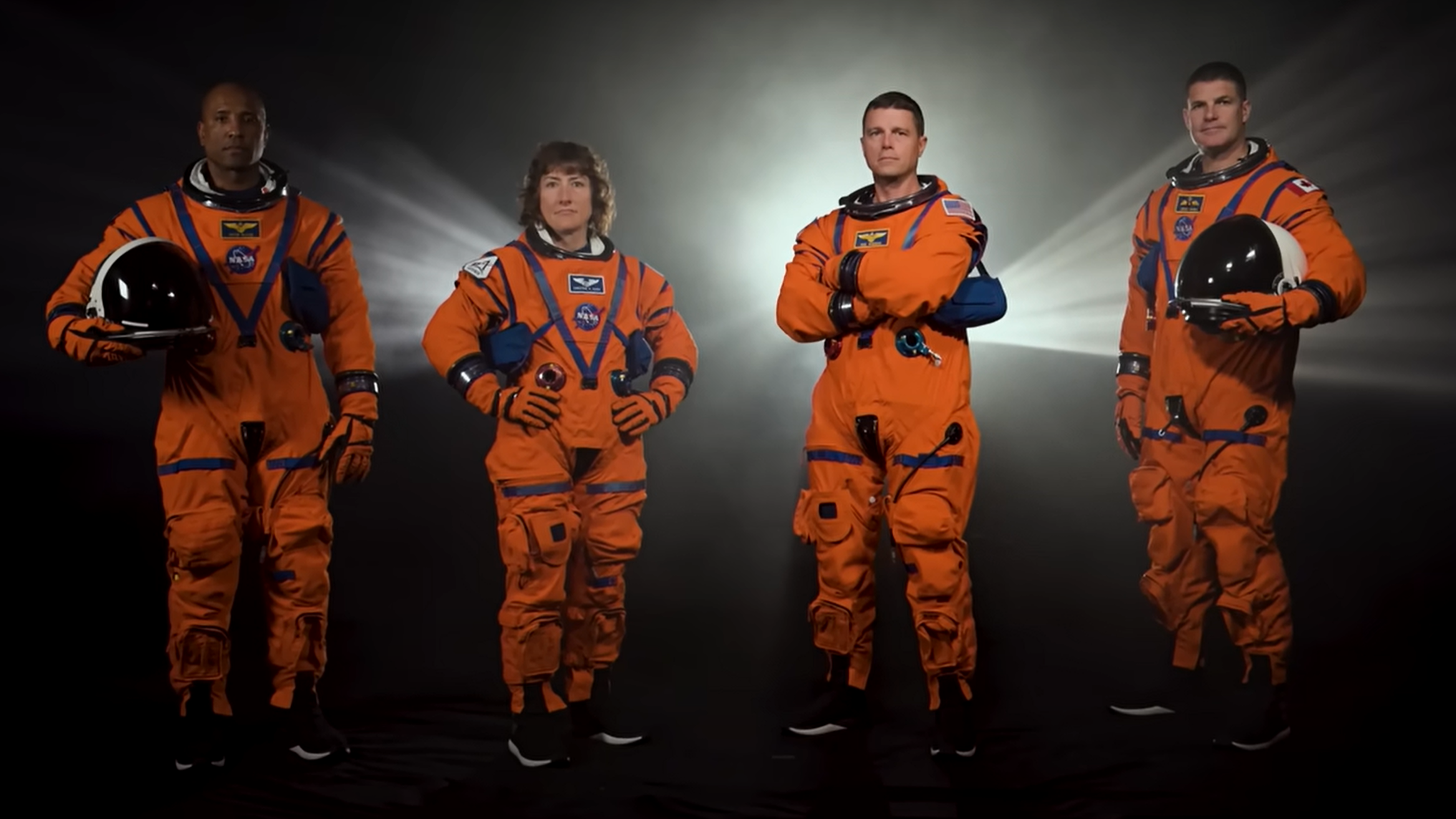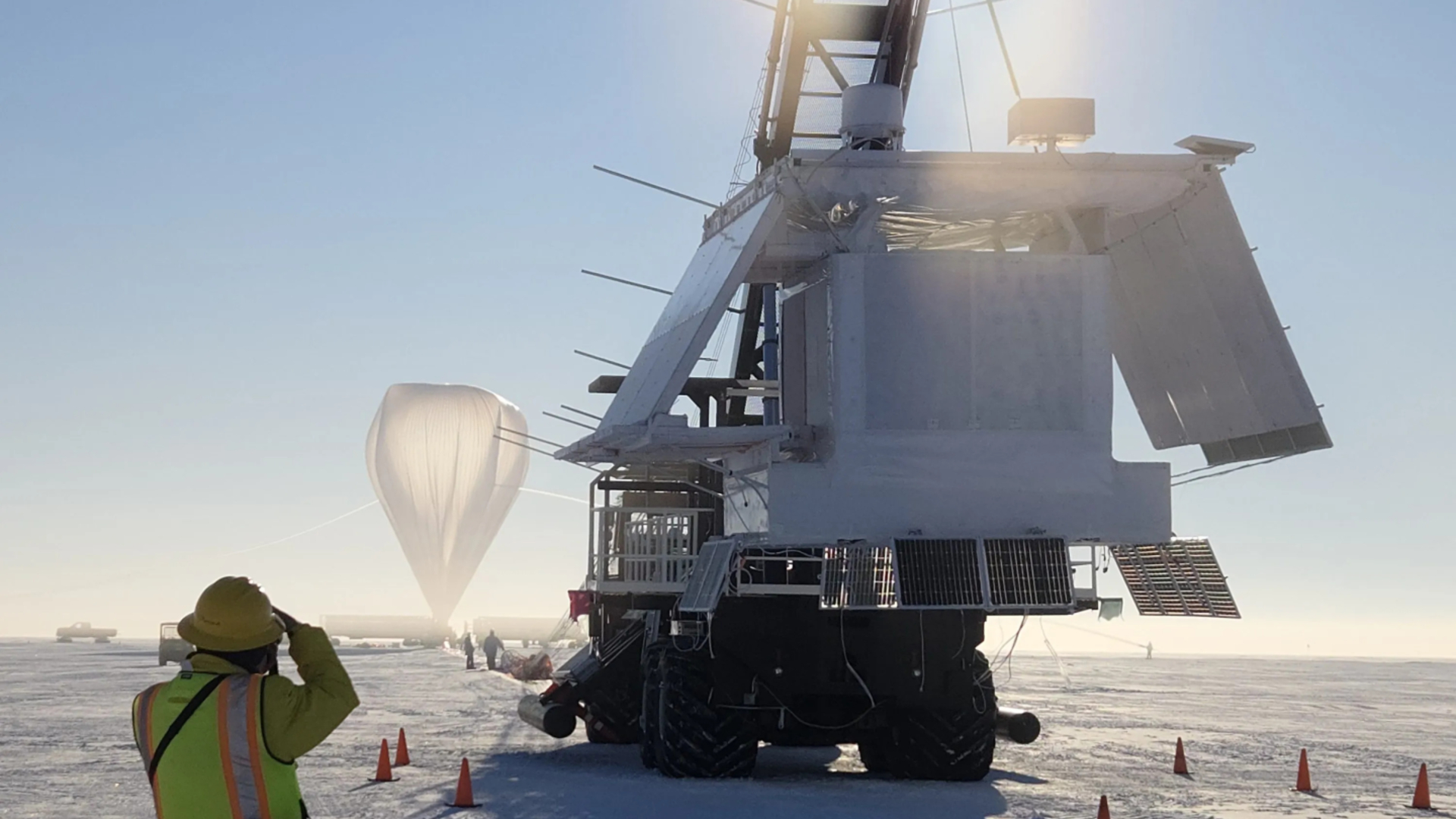How Artemis 2 astronauts are training for their 2024 moon mission
"They're making sure: 'Okay, our life support's working. Yep, we're able to eat."'

The first moon-bound astronauts in 52 years have a remarkable amount of diversity informing their training.
The four Artemis 2 astronauts headed for the moon in November 2024 include a woman, a person of color and a Canadian. Between them, they've flown on SpaceX's Dragon capsule, Russia's Soyuz spacecraft, the International Space Station, in free-flying spacesuits on spacewalks, and on dozens of aircraft types. Their collective career experience includes visits to Antarctica and the U.S. Senate, combat missions and landing on naval carrier aircraft.
Now the quartet — NASA's Reid Wiseman, Victor Glover, Christina Koch and the Canadian Space Agency's Jeremy Hansen — are deep in training for their coming around-the-moon mission. Lead training officer Jacki Mahaffey told Space.com that she's integrating as much of the astronauts' experience as possible into the training flow.
"They're coming at us with different backgrounds and perspectives and experiences," said Mahaffey, speaking Monday (July 24) on the 54th anniversary of the splashdown of the first human moon-landing mission, Apollo 11.
"They're part of these conversations of, What's the timeline? What are the concepts for getting their spacesuits on, or to ingress into the vehicle on launch day?" Mahaffey continued. "They can bring all these bits and pieces of things that have worked well — and things that we maybe need to think about or watch out for— and coalesce to help the (training) teams build plans that are going to work."
Related: Four for the moon! NASA names Artemis 2 astronaut crew for 1st lunar mission since Apollo
NASA's Artemis program, which aims to put boots on the moon with Artemis 3 in 2025 or 2026 if schedules hold, builds on a suite of space experience not available to the career-pilot Apollo crews. Able as these men were in executing the first crewed moon missions between 1968 and 1972, Artemis aims to bring in more nations, genders and ethnicities as NASA builds what officials say will be a permanent lunar presence.
Breaking space news, the latest updates on rocket launches, skywatching events and more!
NASA has accelerated diversity efforts since 2010, and after Apollo took steps to redress discrimination among some astronaut groups (as well as its workforce at large). Only one scientist-astronaut (Harrison "Jack" Schmitt) walked on the moon, for example, on Apollo 17 in 1972. Today, scientists consistently fly on ISS missions. Women and Black astronauts were finally welcomed at NASA in 1978, six years after the last moon landing. And, aside from a 1975 joint mission with the Soviet Union, non-American astronauts began flying with NASA regularly in 1983.
Related: Diversity will be key to Artemis moon-to-Mars push, NASA officials say
Mahaffey also pointed to Artemis' vehicles being very different than those of the Apollo era. There are different sizes and shapes. Touchscreens fly on the SpaceX Dragon, which would have felt like "Star Trek" to Apollo astronauts in the age of flipping switches, punching programs into computers and turning dials. Quiet revolutions have been made in materials, power supplies and life support. All of this also informs the training from the systems side.
The biggest difference from Apollo, Mahaffey added, is the sheer accumulation of experience gained on the ISS. It has been occupied continuously for nearly 23 years, with hundreds of astronauts gathering valuable data on how the human body behaves in microgravity. Though the Orion spacecraft NASA will use for Artemis 2 has had no human crew members yet, the ISS experience is relatable enough for a pivot — although Mahaffey cautioned everyone involved (astronauts and those on the ground) will need to be "flexible and adaptable" as the circumstances require.
One of Artemis 2's main goals is to test life support on board Orion. The vehicle has flown two space missions to date, most recently with the moon-circling Artemis 1 in late 2022. But these efforts were both uncrewed. Artemis 2's astronauts will be the first to fly the spacecraft, and the first to go to space atop the massive NASA Space Launch System (SLS) rocket.
A day of testing in Earth orbit will take place during Artemis 2, to make sure all is well before the mission starts flying to the moon. "They're making sure: 'Okay, our life support's working. Yep, we're able to eat. We are able to get rid of what we eat. We're working sufficiently to actually head out to the moon,'" Mahaffey said.
At least a couple of the astronauts will also test Orion in an "interesting little event," she said. The procedure is meant to simulate docking with a future lander or with the Gateway space station, which NASA plans to build in lunar orbit later in the 2020s. The proximity operations demonstration, as NASA calls it, will see Orion nestle up close to the the SLS second stage. The Interim Cryogenic Propulsion Stage (ICPS) will "actually hang around" for the astronauts to test tracking a target on it, and to fly near it.
"This is starting to get our first opportunity to see, What is it like to actually fly Orion? Does it feel like what our simulators have calculated it's going to feel like? Is that going to work, and be sufficient for when we actually have to dock with a lander or dock with Gateway?" Mahaffey said.
The training flow for Artemis 2 is relatively long for Artemis missions, at 18 months, to make sure the astronauts are prepared for "more flavors of contingencies" and "changes to the procedures or the software," Mahaffey said.
Some things are deliberately different, too, as Artemis 2 was never meant to be a landing mission. (SpaceX's Starship, the lunar lander for Artemis 3, is in development and launched for the first time in April.) Normally, the mission specialists on a landing mission would be occupied with surface activities. On Artemis 2, however, Koch and Hansen will instead use the time on Orion flight training — spending valuable hours to understand the ship with different piloting styles and "brains," as Mahaffey termed it.
Change is the nature of developmental programs, she emphasized, but the big pieces are already in there. The crew will test their skills in the classroom, in simulators, in groups and also with other teams (most especially the ground teams at Mission Control.)
Facilities will literally be all over the map of North America, at the least. The training setup includes simulators at NASA's Johnson Space Center in Houston; integrated training in Florida with the Exploration Grounds Systems team, which just completed its first simulated launch for Artemis 2; sea recovery operations at Naval Base San Diego, which the astronauts recently visited; and geology work. Coming up in September, for example, Hansen and Koch will travel to Mistastin Crater, located in Canada's Labrador region near the Atlantic Ocean.
Mahaffey says there are hundreds of people involved in the Artemis 2 training; the instructor email distribution list for flight operations alone features 85 individuals. (Like astronaut crews, this instructor set includes both prime and backup members.)
Many of the trainers involved with Artemis 2 have particular roles on ground systems as well, which is deliberate. These instructors not only provide learning opportunities but also a familiar face and voice to the crew, should a question arise while the astronauts are in space.
"We liked the fact that they can come in and say, 'I'm going to give you an introduction on the audio systems onboard the vehicle. And by the way, if you have a problem with them during flight, I'm going to be the one on the ground troubleshooting them,'" Mahaffey said.
"The crew likes to see that, meet those people and have the connections. That way, they're already forming a cohesive team between the ground and all of them."

Elizabeth Howell (she/her), Ph.D., was a staff writer in the spaceflight channel between 2022 and 2024 specializing in Canadian space news. She was contributing writer for Space.com for 10 years from 2012 to 2024. Elizabeth's reporting includes multiple exclusives with the White House, leading world coverage about a lost-and-found space tomato on the International Space Station, witnessing five human spaceflight launches on two continents, flying parabolic, working inside a spacesuit, and participating in a simulated Mars mission. Her latest book, "Why Am I Taller?" (ECW Press, 2022) is co-written with astronaut Dave Williams.

